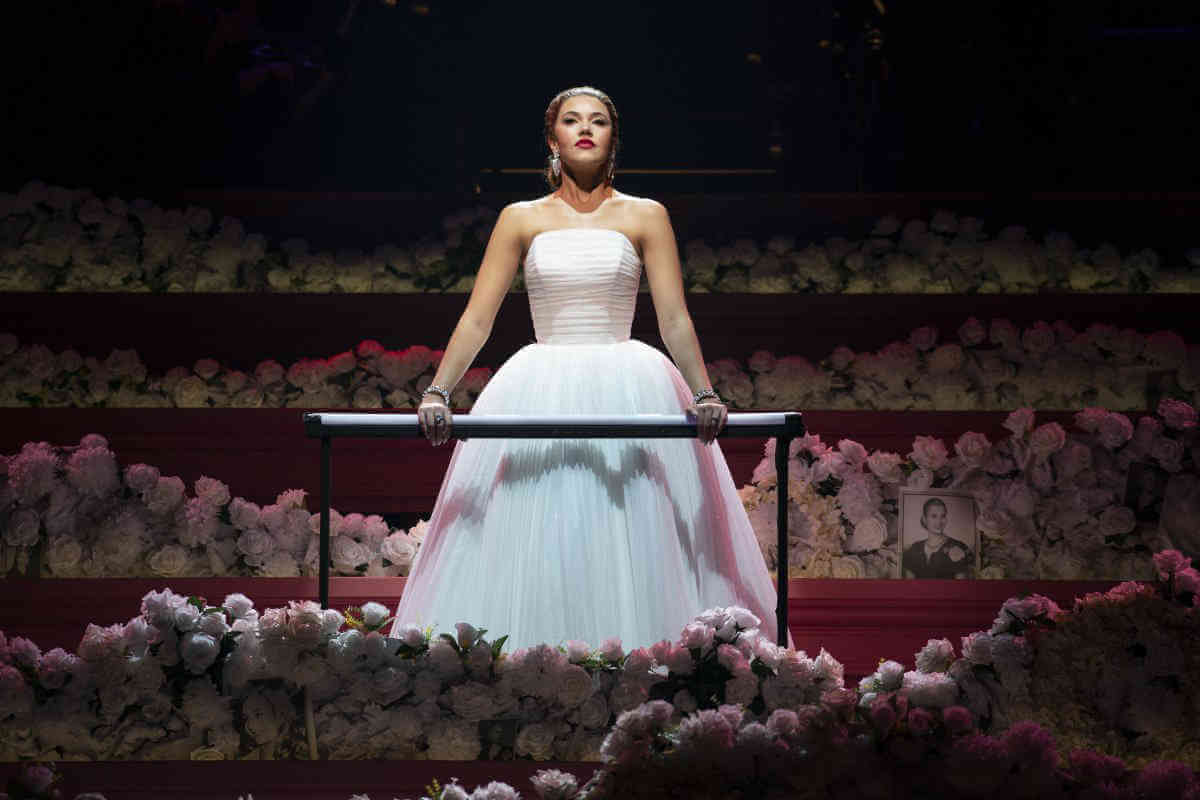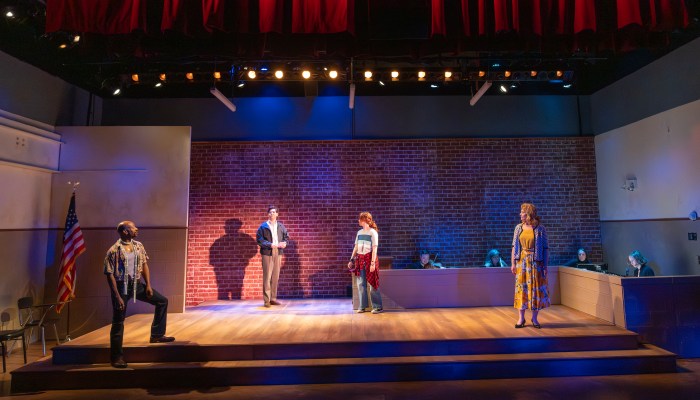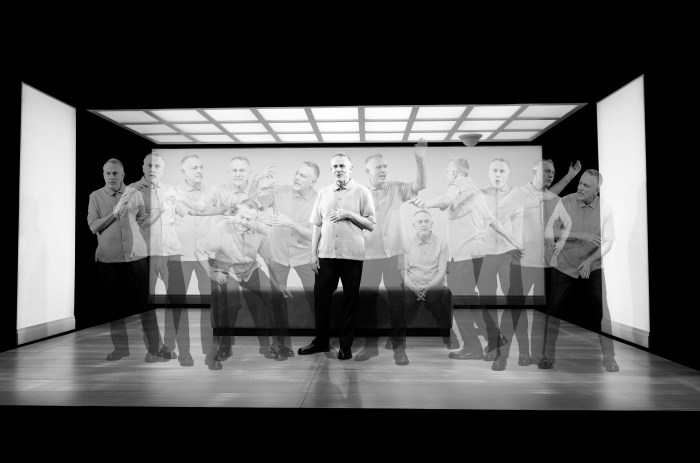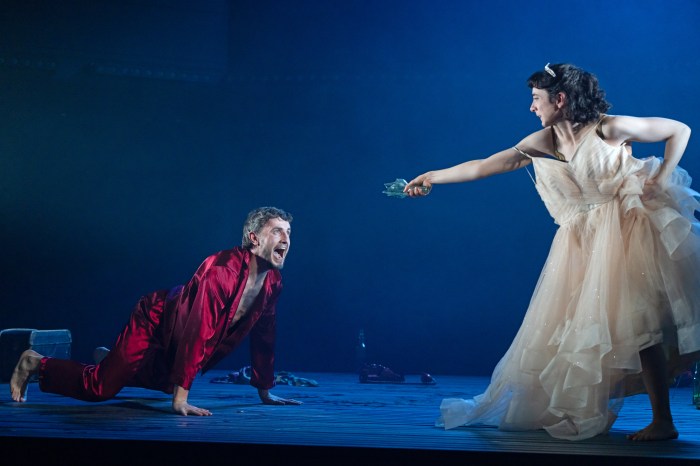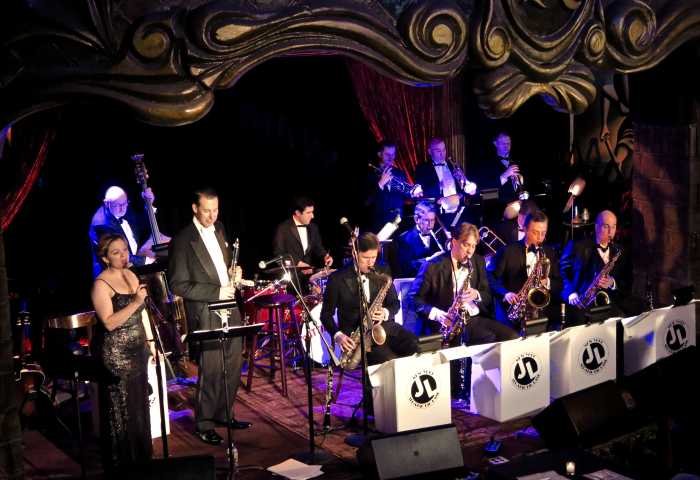A visit to the Museo Evita in Buenos Aires will tell you the real Evita, Maria Eva Duarte de Perón, first lady of Argentina, was a petite woman, her shoes on display evidence of just how tiny her feet were. But filling those shoes when it comes to the towering mythical figure of Evita on Broadway in the Andrew Lloyd Webber and Tim Rice musical is another thing entirely.
We all know who filled them before — Patti, Madonna, Dunaway, and more, many of them the reason I’ve discussed Evita’s legacy as a gay icon before in Gay City News. Now, in the 100th anniversary year of Evita’s birth, a new short run production directed by Sammi Cannold tries to fill those shoes in Manhattan’s City Center, through November 24. The question “What’s new, Buenos Aire?” is more pertinent than ever in a play promoting the role of women and Latin Americans in theater.
One thing new is more than one actress tries to fill those shoes: young wide-eyed Eva Perón, played by the Argentinian-American actress Maia Reficco, and the mature, transformed Evita, played by Solea Pfeiffer. Reficco is the second Argentine to play Evita in a major New York production. Olivier-winning Elena Roger shared the stage with Ricky Martin’s Che Guevara and Michael Cerveris’ Juan Perón in the 2012 production.
Young Eva morphs into the mature, sexually confident Evita in the course of the “What’s new, Buenos Aires?’ scene. The actresses switch out during a cringe-inducing dance struggle with numerous men, including what appears to be a frenzied gang rape. It’s a reminder in the #MeToo era that despite her power over men, Eva endured horrors while biting into Argentina’s Big Apple.
The purpose of the dual-casting twist is revealed through the rest of the play, where a sentimental Evita is haunted by her younger version, always appearing on the corner of the stage, destitute and forgotten, suitcase in hand. In death the two reunite, tearful young Eva comforted by her older goddess-like self.
The famous white dress is itself a character, disembodied, looming over the stage at the beginning, a reminder of Eva Perón as ghost, goddess, icon, and idol, carried over her own weak body by pallbearers as she confusedly watches her own funeral during Requiem. During the melodic “Don’t Cry For Me” scene, conducted by Kristen Blodgette, Pfeiffer finally appears cocooned within the sparkling confection. Stripped-down staging by Jason Sherwood means her balcony is hinted by a portable industrial staircase, and as she descends, she pulls the dress’ sides up around her. Seen from high vantage points including the theater’s balcony seats under the dramatic lighting by Bradley King, the dress appears to have a long train flowing down the steps, as if she were being presented as a bride to the people of Argentina. Once on the ground, suspended inside layers of tulle, Evita swirls like a cloud as she moves across the stage. You’ll have to see the play to learn the dress’s ill fate.
Color is key. Whether for purity or to remind us of the ghost she becomes, Eva is always in white, including some gorgeous New Look ensembles highlighting Pfeiffer’s statuesque sensuality by costume designer Alejo Vietti. Che, played by Jason Gotay, is in black. Everyone in the chorus falls within 50 shades of gray: the descamisados in the palest shades, the wealthy in the middle, and the military, including Perón, played by Enrique Acevedo, dark and somber.
Naturally, there’s plenty of star quality tango, but flourishes of other moves from the ensemble especially embellish the effervescent “And the Money Kept Rolling In” scene.
Importantly, tango is reinterpreted for “I’d Be Surprisingly Good For You,” honoring Juan and Evita’s first night of lovemaking. I saw the play twice, and on the first night, I wasn’t sure if the normally rigid gender rules of tango were being broken, with Eva and Juan taking turns leading each other in the dance. On the second night, my thoughts were confirmed. If you don’t know the dance, whenever you see Eva pressing her pretty little hands on the small of Juan’s back, she’s taking the lead. Co-choreographer for the show Valeria Solomonoff, herself from Rosario, Argentina, Guevara’s hometown, told me this was part of the design, explaining, her hands in the air mimicking the positions, “She asks to lead, and he accepts.” It’s never represented as a fight, instead shared and negotiated with each other’s constant consent, symbolizing their relationship.
This production is being put on in the age of Donald Trump mere blocks from his eponymous tower, and we might want to think about some parallels with Perón. They were both fascistic media curiosities who used journalists to gain political power, only to turn on them as enemies of the people. Like Trump, Perón loved popping into actresses’ dressing rooms. Though “Night of a Thousand Stars” represents Juan and Evita’s mythical meeting at Luna Park, it’s generally believed they met earlier. Perón was known for targeting underage girls, alluded to in the “Another Suitcase in Another Hall” scene where Eva throws out a very young mistress. Like Eva, Melania is a beautiful clotheshorse and model who sought worthier pastures.
Like Trump, Perón had three wives. Eva was his second; she and the first died of the same cancer. The last wife, Isabel, was a nightclub dancer Perón met in exile and is still alive. Nicknamed Isabelita, she was the first female president of Argentina — in fact, the first to take the title of president in any country. She held power upon Perón’s death during his second administration in 1974 until the 1976 military coup.
Eva’s failed vice presidential ambitions might call to mind the shattered dreams of former First Lady Hillary Clinton, another woman whose power was initially drawn from her husband. It’s also important to remember that at the time of Perón’s ascent, Argentina was the world’s second wealthiest country. As we are with China today, the US was engaged in a global trade war with Argentina, our only real economic rival then. Evita’s “Rainbow Tour” seems a jokey bauble you can brush aside in the play, but as it was meant to promote trade with Europe in the aftermath of World War II and it frightened the US into writing trade restrictions into the Marshall Plan, shutting Argentina out of a rebuilding Europe. The Peróns, to be sure, didn’t handle the Argentine economy well, but the US helped dim the lights.
This latest production detailing the downfall of a once wealthy and powerful nation under a charming megalomaniacal leader who manipulated the masses is a reminder of the spiral any country can experience in the wrong hands.
Sing lamentations, not just for Eva. It’s our funeral too.
EVITA | New York City Center, 131 W. 55th St. | Nov. 19-21 at 7:30 p.m.; Nov. 22-23 at 8 p.m.; Nov. 23-24 at 2 p.m. | $50-$195 at nycitycenter.org


